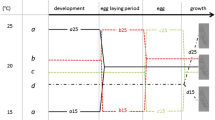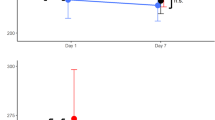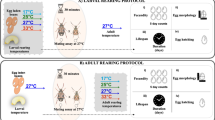Abstract
Phenotypic plasticity may allow an organism to adjust its phenotype to environmental needs. However, little is known about environmental effects on offspring biochemical composition and turnover rates, including energy budgets and developmental costs. Using the tropical butterfly Bicyclus anynana and employing a full-factorial design with two oviposition and two developmental temperatures, we explore the consequences of temperature variation on egg and hatchling composition, and the associated use and turnover of energy and egg compounds. At the lower temperature, larger but fewer eggs were produced. Larger egg sizes were achieved by provisioning these eggs with larger quantities of all compounds investigated (and thus more energy), whilst relative egg composition was rather similar to that of smaller eggs laid at the higher temperature. Turnover rates during embryonic development differed across developmental temperatures, suggesting an emphasis on hatchling quality (i.e. protein content) at the more stressful lower temperature, but on storage reserves (i.e. lipids) at the higher temperature. These differences may represent adaptive maternal effects. Embryonic development was much more efficient at the lower temperature, providing a possible mechanism underlying the temperature-size rule.





Similar content being viewed by others
References
Angilletta MJ, Dunham AE (2003) The temperature-size rule in ectotherms: simple evolutionary explanations may not be general. Am Nat 162:332–342
Atkinson D (1994) Temperature and organism size—a biological law for ectotherms? Adv Ecol Res 25:1–58
Atkinson D, Morley SA, Hughes RN (2006) From cells to colonies: at what levels of body organization does the ‘temperature-size rule’ apply? Evol Dev 8:202–214
Azevedo RBR, French V, Partridge L (1997) Life-history consequences of egg size in Drosophila melanogaster. Am Nat 150:250–282
Baur A, Baur B (1997) Seasonal variation in size and nutrient content of eggs of the land snail Arianta arbustorum. Inver Rep Dev 32:55–62
Beenakkers AMT, Vanderhorst DJ, Vanmarrewijk WJA (1985) Insect lipids and lipoproteins, and their role in physiological processes. Prog Lipid Res 24:19–67
Bernardo J (1996) The particular maternal effect of propagule size, especially egg size: patterns, models, quality of evidence and interpretations. Am Zool 36:216–236
Booth DT, Kiddell K (2007) Temperature and the energetics of development in the house cricket (Acheta domesticus). J Insect Physiol 53:950–953
Brakefield PM (1997) Phenotypic plasticity and fluctuating asymmetry as responses to environmental stress in the butterfly Bicyclus anynana. In: Bijlsma RR, Loeschcke V (eds) Environmental stress: adaption and evolution. Birkhäuser, Basel
Brakefield PM, Mazzotta V (1995) Matching field and laboratory environments—effects of neglecting daily temperature-variation on insect reaction norms. J Evol Biol 8:559–573
Brakefield PM, Reitsma N (1991) Phenotypic plasticity, seasonal climate and the population biology of Bicyclus butterflies (Satyridae) in Malawi. Ecol Entomol 16:291–303
Chapman RF (1998) The insects: structures and function. Cambridge University Press, Cambridge
Diss AL, Kunkel JG, Montgomery ME, Leonard DE (1996) Effects of maternal nutrition and egg provisioning on parameters of larval hatch, survival and dispersal in the gypsy moth, Lymantria dispar L. Oecologia 106:470–477
Eckert R, Randall D, Burggren W, French K (2002) Tierphysiologie. Thieme, Stuttgart
Fischer K, Bot ANM, Brakefield PM, Zwaan BJ (2003a) Fitness consequences of temperature-mediated egg size plasticity in a butterfly. Funct Ecol 17:803–810
Fischer K, Bot ANM, Brakefield PM, Zwaan BJ (2006) Do mothers producing large offspring have to sacrifice fecundity? J Evol Biol 19:380–391
Fischer K, Brakefield PM, Zwaan BJ (2003b) Plasticity in butterfly egg size: why larger offspring at lower temperatures? Ecology 84:3138–3147
Fox CW, Thakar MS, Mousseau TA (1997) Egg size plasticity in a seed beetle: an adaptive maternal effect. Am Nat 149:149–163
Ganong W (1974) Lehrbuch der medizinischen Physiologie. Springer, Berlin
Garcia-Guerrero M, Villarreal H, Racotta IS (2003) Effect of temperature on lipids, proteins, and carbohydrates levels during development from egg extrusion to juvenile stage of Cherax quadricarinatus (Decapoda : Parastacidae). Comp Biochem Physiol A 135:147–154
Gilchrist GW, Huey RB (2001) Parental and developmental temperature effects on the thermal dependence of fitness in Drosophila melanogaster. Evolution 55:209–214
Gillot C (2005) Entomology. Springer, New York
Giron D, Casas J (2003) Mothers reduce egg provisioning with age. Ecol Lett 6:273–277
Guisande C, Harris R (1995) Effect of total organic content of eggs on hatching success and naupliar survival in the copepod Calanus helgolandicus. Limnol Oceanogr 40:476–482
Jaeckle W (1995) Variation in the size, energy content, and biochemical composition of invertebrate eggs: correlates to the mode of larval development. In: McEdward L (ed) Ecology of marine invertebrate larvae. CRC Press, Boca Raton, pp 49–77
Jarošík V, Kratochvil L, Honek A, Dixon AFG (2004) A general rule for the dependence of developmental rate on temperature in ectothermic animals. Proc R Soc Lond B Biol Sci 271:S219–S221
Karl I, Fischer K (2008) Why get big in the cold? Towards a solution to a life-history puzzle. Oecologia 155:215–225
Karl I, Lorenz MW, Fischer K (2007) Energetics of reproduction: consequences of divergent selection on egg size, food limitation, and female age for egg composition and reproductive effort in a butterfly. Biol J Linn Soc 91:403–418
Larsen TB (1991) The butterflies of Kenya and their natural history. Oxford University Press, Oxford
Liu SS, Zhang GM, Zhu J (1995) Influence of temperature-variations on rate of development in insects—analysis of case-studies from entomological literature. Ann Entomol Soc Am 88:107–119
Lorenz MW (2003) Adipokinetic hormone inhibits the formation of energy stores and egg production in the cricket Gryllus bimaculatus. Comp Biochem Physiol B 136:197–206
Lyytinen A, Brakefield PM, Lindstrom L, Mappes J (2004) Does predation maintain eyespot plasticity in Bicyclus anynana? Proc R Soc Lond B Biol Sci 271:279–283
Marshall DJ, Uller T (2007) When is a maternal effect adaptive? Oikos 116:1957–1963
McIntyre GS, Gooding RH (2000) Egg size, contents, and quality: maternal-age and -size effects on house fly eggs. Can J Zool 78:1544–1551
Miner BG, Sultan SE, Morgan SG, Padilla DK, Relyea RA (2005) Ecological consequences of phenotypic plasticity. Trends Ecol Evol 20:685–692
Mousseau TA, Dingle H (1991) Maternal effects in insect life histories. Annu Rev Entomol 36:511–534
Mousseau TA, Fox CW (1998a) The adaptive significance of maternal effects. Trends Ecol Evol 13:403–407
Mousseau TA, Fox CW (1998b) Maternal effects as adaptations. Oxford University Press, New York
Nijhout HF (1999) Control mechanisms of polyphenic development in insects - in polyphenic development, environmental factors alter same aspects of development in an orderly and predictable way. Bioscience 49:181–192
Pigliucci M (2005) Evolution of phenotypic plasticity: where are we going now? Trends Ecol Evol 20:481–486
Robinson SJW, Partridge L (2001) Temperature and clinal variation in larval growth efficiency in Drosophila melanogaster. J Evol Biol 14:14–21
Rose MR, Bradley TJ (1998) Evolutionary physiology of the cost of reproduction. Oikos 83:443–451
Rossiter MC (1996) Incidence and consequences of inherited environmental effects. Annu Rev Ecol Syst 27:451–476
Sakwínska O (2004) Persistent maternal identity effects on life history traits in Daphnia. Oecologia 138:379–386
Silbernagel S, Despopolos A (1991) Taschenatlas der physiologie. Thieme, Stuttgart
Stearns SC (1989) The evolutionary significance of phenotypic plasticity—phenotypic sources of variation among organisms can be described by developmental switches and reaction norms. Bioscience 39:436–445
Stearns SC (1992) The evolution of life-histories. Oxford University Press, New York
Steigenga MJ, Zwaan BJ, Brakefield PM, Fischer K (2005) The evolutionary genetics of egg size plasticity in a butterfly. J Evol Biol 18:281–289
Thompson SN, Borchardt DB, Wang LW (2003) Dietary nutrient levels regulate protein and carbohydrate intake, gluconeogenic/glycolytic flux and blood trehalose level in the insect Manduca sexta L. J Comp Physiol B 173:149–163
Van Handel E (1993) Fuel metabolism of the mosquito (Culex quinquefasciatus) embryo. J Insect Physiol 39:831–833
Van’t Hof AE, Zwaan BJ, Saccheri IJ, Daly D, Bot ANM, Brakefield PM (2005) Characterization of 28 microsatellite loci for the butterfly Bicyclus anynana. Mol Ecol Notes 5:169–172
Wagner TL, Wu HI, Sharpe PJH, Schoolfield RM, Coulson RN (1984) Modeling insect development rates—a literature-review and application of a biophysical model. Ann Entomol Soc Am 77:208–225
Walters RJ, Hassall M (2006) The temperature-size rule in ectotherms: may a general explanation exist after all? Am Nat 167:510–523
Wilson RS, Franklin CE (2002) Testing the beneficial acclimation hypothesis. Trends Ecol Evol 17:66–70
Windig JJ (1994) Reaction norms and the genetic-basis of phenotypic plasticity in the wing pattern of the butterfly Bicyclus anynana. J Evol Biol 7:665–695
Wolf JB, Brodie ED (1998) The coadaptation of parental and offspring characters. Evolution 52:299–308
Woods HA, Harrison JF (2002) Interpreting rejections of the beneficial acclimation hypothesis: when is physiological plasticity adaptive? Evolution 56:1863–1866
Ziegler R, Van Antwerpen R (2006) Lipid uptake by insect oocytes. Insect Biochem Mol Biol 36:264–272
Acknowledgments
We thank Susann Janowitz and Jana Perlick for helping out on two occasions with the experiments. Financial support was provided by the German Research Foundation (DFG grants Fi 846/1-3 and 1-4 to KF, DFG grants Lo 697/4-3 and 4-4 to MWL and a scholarship within the Graduate College 678/2 to TLG).
Author information
Authors and Affiliations
Corresponding author
Additional information
Communicated by G. Heldmaier.
Rights and permissions
About this article
Cite this article
Geister, T.L., Lorenz, M.W., Hoffmann, K.H. et al. Energetics of embryonic development: effects of temperature on egg and hatchling composition in a butterfly. J Comp Physiol B 179, 87–98 (2009). https://doi.org/10.1007/s00360-008-0293-5
Received:
Revised:
Accepted:
Published:
Issue Date:
DOI: https://doi.org/10.1007/s00360-008-0293-5




